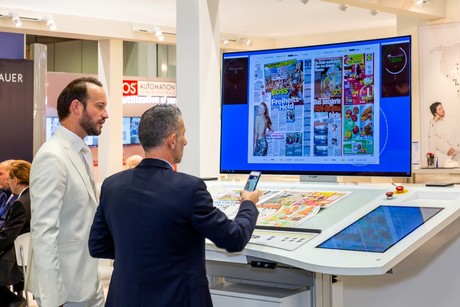manroland's One Touch vision of fully-automated newspaper production has been realised here to the largest extent to date: it is not just CTP plate production that is automatic, but also plate transport via a complex rail system up to and into the press. Plating is usually also done without any manual intervention. Robots are uased at two positions in the production process: loading the plate transport cassettes and plate changing. manroland's technical partner for the rail system is Swisslog, a company specialising in transport solutions.
The production equipment – from plate production (Krause and Nela) to printing (manroland) and up to the mailroom (Müller Martini) – was compeletly modernised within one year. ppi Media's printnet system controls and supervises the workflow.
At the time of modernising the equipment, it was possible to reduce the number of production lines from four to two, made possible on the one hand by the higher production speed and level of automation and on the other hand by lower circulations. This slimming-down freed up space to the benefit of biber post, the private mail delivery service that will now move into the mailroom.
Print production was outsourced initially for daytime production (e.g. freesheets) and later on also nighttime newspaper production to R. Weeke Betriebs GmbH und Co. KG. The company owns and operates the production equipment.
At the core of the printing centre is the new COLORMAN autoprint press that features numerous automative modules, e.g. inline control systems and plate changing robots and that permits minimum manning levels (there is no labour agreement specifying minimum manning levels) as well as shorter changeover times.
Plate production Just-in-Sequence
Especially impressive is the APL logistics plate management system, of which the level of automation was increased in a phased process:
Phase 1: Use of the sorting system; plate cassette are filled manually and taken to the press, manual plating,
Phase 2: Use of the sorting system; plate cassettes are filled manually and brought to the printing unit by a transport system, manual plating,
Phase 3: Plate are placed on the delivery belt in the correct sequence; manual sorting into the plate cassette; automatic transport to the printing unit,
Phase 4: vollautomatischer Betrieb.
 The APL logistics process in Barleben
The APL logistics process in Barleben
The printnet OM output manager drives the two high-speed Krause imagers. NELA systems carry out punching and edge bending as well as the transport of the plates up to their pick-up by and industrial robot. The robot fills the transport boxes that then convey the plates into the correct printing unit via a system of rails and switches. The plate changing robot automatically removes the plates from the cassettes. The fact that during plate production many plates are in transit in the transport boxes means that the rail system system itself also acts as a buffer for finished plates. The movement of large numbers of transport boxes at ceiling level – filled with plates heading towards the press and empty boxes returning to the loading station – give the impression of being in the mailroom rather than in the press hall.
"Although the integration of a roboter may be the most impressive aspect of this configuration, the entire complexity of the installation is actually in the software which ensures that hundreds of plates are produced in the correct sequence and delivered just-in-time to the correct printing unit", says Moritz Schwarz, WAN-IFRA Consultant,who availed of the opportunity to personally inspect the installation.
In the event of an incident or of individual plates must be delivered in addition, it is possible at all times to scale-back the level of automation, e.g. by switching on the sorter-stacker or returning to manual operation.
According to manroland, twelve newspaper printing plants are now producing with the COLORMAN autoprint – with major steps in the direction of full automation. But the printing centre in Barleben is the reference operation for manroland, because nowehere else has yet come so clase to realising the One Touch vsion of completely automated newspaper production. For its presentation at IFRA Expo 2011 (10 to 12 October in Vienna) manroland (stand B310) has chosen the concept of "printing at the push of a button" as its main topic.



